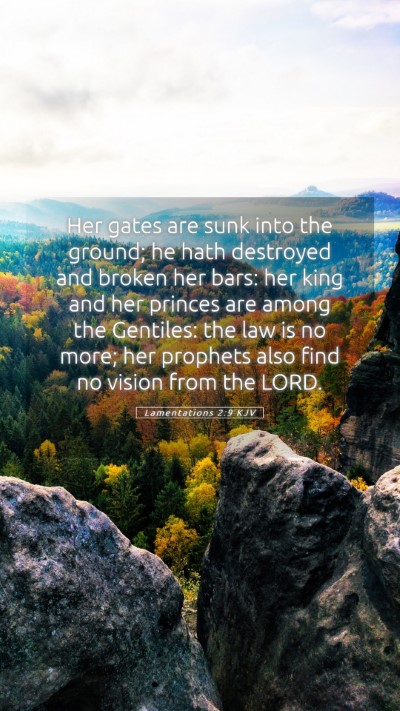Lamentations 2:9 - A Comprehensive Bible Verse Commentary
Bible Verse: Lamentations 2:9
Meaning of the Verse: In Lamentations 2:9, we witness profound sorrow and desolation. The verse states: “Her gates are sunk into the ground; He has destroyed and broken her bars. Her king and her princes are among the nations; the law is no more, and her prophets find no vision from the Lord.” This heartbreak reflects the depth of despair faced by Jerusalem after its fall, highlighting God's judgment and the tragic consequences of disobedience.
Understanding the Context
This verse is situated within a poetic lament attributed to the prophet Jeremiah, expressing the collective grief of Israel after the Babylonian conquest of Jerusalem. The format of Lamentations is an acrostic, symbolizing the completeness of grief experienced by the nation, emphasizing their utter devastation.
Insights from Public Domain Commentaries
-
Matthew Henry's Commentary:
Henry emphasizes the hopelessness that permeated Jerusalem, likening the fallen gates of the city to the complete removal of safety and protection. He notes that the existential devastation includes the absence of leaders, indicating that both the civil and spiritual systems have crumbled.
-
Albert Barnes' Notes:
Barnes highlights the significance of the city gates, which traditionally symbolize strength and defense. Their "sinking" denotes defeat and abandonment. He observes that the absence of the law and prophetic vision implies a loss of divine guidance, leading to moral and national disarray, aligning with Israel's historical rebellion against God.
-
Adam Clarke's Commentary:
Clarke elaborates on the destruction of Jerusalem, referring to the devastation that the people felt. The verse portrays the hopeless state of the Jewish nation, stripped of its leaders and divine counsel, inducing a profound spiritual crisis and hopelessness among the people.
Biblical Exegesis and Historical Context
The historical context surrounding Lamentations 2:9 is crucial for understanding its meaning. Following the Babylonian siege, Jerusalem faced complete destruction. The loss of the temple and the exile of its inhabitants were primary consequences of the nation's sin against God. This context shapes the interpretation of the verse, portraying both physical and spiritual desolation.
Application of the Verse to Daily Life
Lamentations 2:9 serves as a stark reminder of the consequences of turning away from divine instruction and guidance. In a contemporary setting, the verse urges believers to reflect on their spiritual lives, the importance of spiritual leaders, and the necessity of adhering to God's words. When leaders falter or divine wisdom is ignored, a community’s moral foundation is jeopardized.
Cross References
- Jeremiah 52:12-14 - Discusses the destruction of Jerusalem and its gates.
- Isaiah 3:1-5 - Portrays the removal of leaders and judgment against Israel.
- Micah 3:6-7 - Highlights the silence of prophets due to sinfulness.
Conclusion
Lamentations 2:9 is profound in its expression of loss, despair, and the absence of divine presence. The verse invites deep contemplation and reflection, essential for personal and communal spiritual growth. Understanding this passage through careful scripture analysis illuminates its relevance, encouraging believers to maintain their commitment to God's teachings and leadership.
Further Bible Study Resources
For those seeking deeper insights into Bible verse meanings and interpretations, consider exploring the following:
- Bible study groups that facilitate discussions around scripture.
- Online Bible study courses that delve into the historical context and application of various verses.
- Bible study guides that provide structured lessons on themes present in the Old Testament and New Testament.


